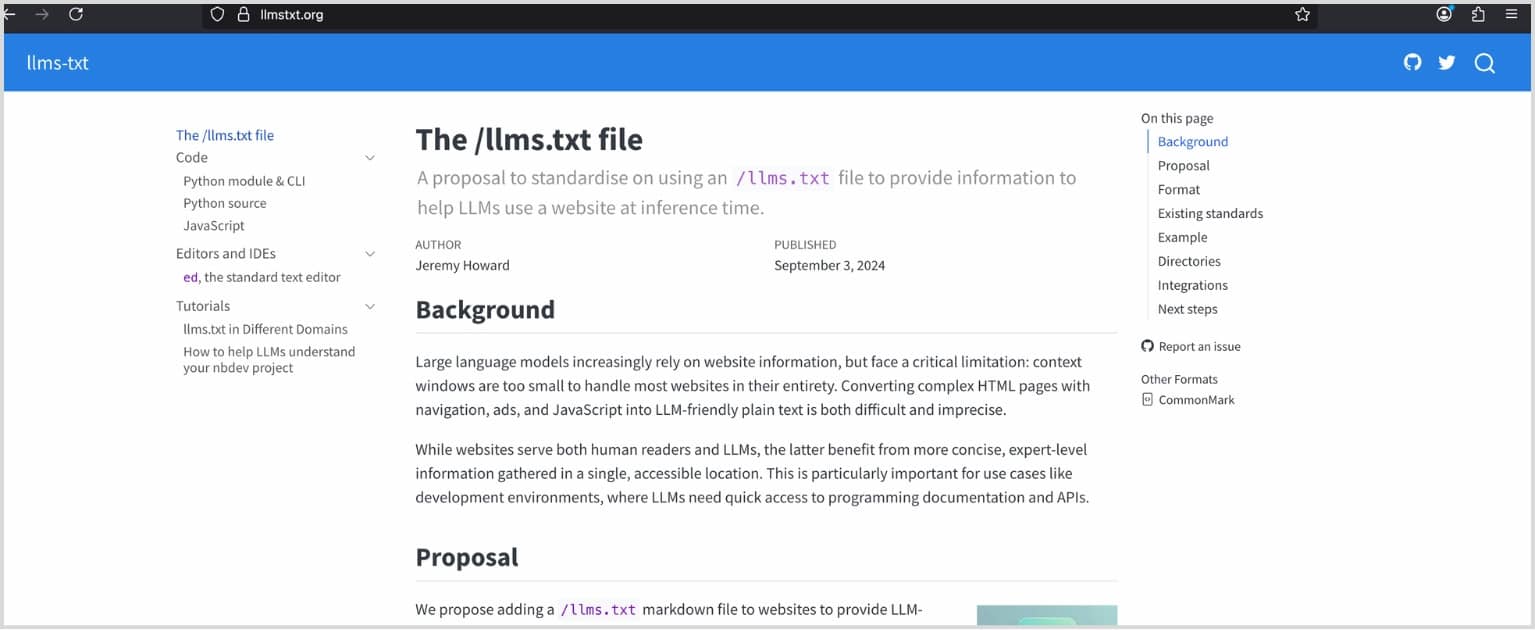If you’ve been hearing about llms.txt and wondering whether your website needs one, you’re not alone. This new file format is a community standard that is gaining attention across the digital marketing world, but like many emerging technologies, it’s surrounded by confusion and mixed advice.
Let’s cut through the noise and give you the facts about llms.txt and whether it’s worth your time.
TL;DR
- What is llms.txt? A simple text file that acts as a roadmap for AI systems, helping them understand your website content (like sitemap.xml but for AI tools).
- Do major AI companies use it? Many are starting to support it, such as OpenAI, Perplexity, and Anthropic.
- Should you implement it? If you’re already executing strong SEO fundamentals, llms.txt is a low-risk way to future-proof your content for AI-driven search.
- Why consider it now? Search is fragmenting with AI overviews and AI-generated results. Websites with good SEO show better visibility in AI responses, and llms.txt helps bridge this gap.
- The bottom line: llms.txt is simple to implement. Focus on proven SEO strategies first, then add llms.txt as a forward-thinking addition to your digital strategy.
- Clickify’s take: We’ve added llms.txt to our site, it’s low risk, easy to implement, and worth doing early.
What is llms.txt?
Think of llms.txt as a roadmap for AI systems. Just like you might create a sitemap.xml file to help Google understand your website structure, llms.txt helps AI tools like ChatGPT, Claude, and Gemini understand what your website contains and where to find your most valuable content.
For the Technically Curious
Unlike the complex HTML that makes up your web pages, llms.txt is a simple text file written in Markdown Format (simple text formatting using symbols like hashtags for headings, asterisks for bold, and brackets for links.) It lives at the root of your website (yoursite.com/llms.txt) and provides a clear, organised overview of your content.
Here’s what a typical llms.txt file might look like for a web development blog:
## Site Overview
Technology blog focused on web development tutorials and industry news
Target audience: Junior to mid-level developers
## Content Structure
- /tutorials - Step-by-step coding guides
- /news - Industry updates and analysis
- /reviews - Tool and framework evaluations
- /about - Company and author information
## Brand Voice
- Conversational but authoritative tone
- Avoid jargon without explanation
- Include practical examples in every tutorial
- Maximum 1500 words per post
## Content Guidelines
- All code examples must be tested
- Include meta descriptions under 160 characters
- Use heading hierarchy (H1 > H2 > H3)
- Target keywords: "web development," "JavaScript tutorials," "React guides"
And for those wondering… llms.txt isn’t robots.txt for AI. It functions more as a curated map, directing AI systems to your most valuable content. Unlike robots.txt which blocks access, llms.txt acts like a menu highlighting valuable resources without restrictions. It’s about curation, not exclusion. The goal is earning citations in AI-generated responses by providing a compass to any buried treasure. Think sitemap.xml for AI: showing where to dig for quality content that deserves attention and potential quotation in answers.
Why Does llms.txt Exist?
AI systems face a challenge when trying to understand websites. Your beautifully designed pages include navigation menus, sidebars, footer links, and advertising that can confuse AI tools trying to extract meaningful information. Llms.txt cuts through this complexity by providing a clean, structured summary of what your site offers.
For example, if someone asks an AI assistant about your industry or the services you provide, a well-crafted llms.txt file helps ensure your content gets recognised and potentially cited in the response.
Proactive vs Reactive
Some forward-thinking companies are already implementing llms.txt files, betting that AI systems will eventually adopt this standard. It’s a bit like SEO in the early days – preparing for what might become important rather than reacting after it already is.
Should Your Website Have llms.txt?
If you’re already executing SEO strategies, fast loading speeds, and quality content creation well, llms.txt represents a low-risk way to future-proof your content strategy. The file is simple to create and maintain, requiring minimal ongoing effort.
Clickify’s Recommendation
Search engines are fragmenting results as AI-powered tools increasingly drive traffic and recommendations. With Google’s AI Overviews launching in Australia in October 2024, we’re witnessing a fundamental shift in search behaviour. Traditional organic clicks are declining industry-wide as users rely more on AI-generated summaries and recommendations.
However, there’s encouraging news: websites with strong SEO performance show better visibility in AI-generated results. Llms.txt helps bridge this gap by providing AI systems with clear, structured information about your content. As search continues evolving toward AI-driven experiences, llms.txt positions your website to be properly understood and cited by these emerging systems. While current reporting tools don’t fully capture this shift, implementing it ensures your content remains discoverable in an AI-first search landscape.
We recommend continuing to focus on proven SEO strategies while adding llms.txt as a low risk, forward-thinking addition to your digital strategy.
The Bottom Line
Llms.txt represents an interesting development in how AI systems might interact with websites in the future becoming valuable as AI continues to evolve.
At Clickify, we believe in staying informed about emerging technologies while focusing on strategies that deliver results today. We’ll continue monitoring llms.txt adoption and keep you updated.
Want to ensure your website is ready for whatever comes next? Let’s discuss your digital strategy and help you prioritise the improvements that will drive real results for your business.


